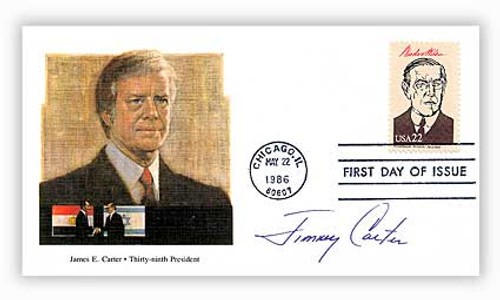
# 57343A - 1986 22c Cover with President Richard Nixon Cachet
Â
Birth Of Richard NixonÂ
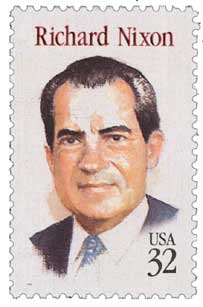
Richard Milhous Nixon was born into a poor Quaker family in Yorba Linda, California, on January 9, 1913.
Nixon excelled as a student and became a successful debater and public speaker during his high school years. While practicing law in California, Nixon participated in a local play, where he met his future wife, Thelma “Pat†Ryan.
Nixon’s political aspirations moved his family to Washington, D.C., in 1942, just as the United States was becoming heavily involved in World War II. A Quaker by birth, Nixon could have been exempt from military service, but he chose to enlist in the Naval Reserves. Early in the war, he served in the South Pacific as a naval passenger control officer. By its end, he had achieved the rank of lieutenant commander.
After the war, Nixon ran for and won a seat in California’s 12th Congressional District. He spent three years in the House, before winning a seat in the Senate. As a Senator, Nixon gave speeches across the country warning of the threat global communism posed. General Dwight Eisenhower soon selected this highly visible young politician as his running mate for the 1952 presidential election. It was during this campaign that Nixon had his first brush with scandal.
Though not illegal per se, vice-presidential candidate Nixon was accused of receiving reimbursement for political expenses from his supporters. If true, this might imply an unethical profit or a conflict of interest. Nixon took the bull by the horns and addressed the country on television – a fairly new media outlet at the time. In an eloquent live speech, Nixon explained to 60 million viewers that no wrongdoing had occurred, except perhaps one campaign gift that he refused to return – a cocker spaniel his six-year-old daughter had already bonded with. The speech was a huge success. Eisenhower and Nixon won the election less than two months later.
As vice president, Nixon had more responsibility than any man previously in the position. He was heavily involved in both domestic and foreign policy. He even acted in Eisenhower’s absence after the President suffered a heart attack and later a stroke, despite there being no constitutional authority for him to do so. But he never overstepped his bounds or tried to assume more power than was required at the time. Nixon’s efforts won him favor with the American public and he could see a successful bid for the presidency in his future.
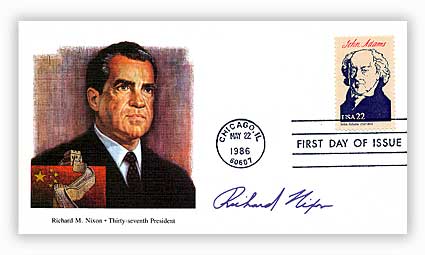
The 1960 presidential race did not work out in Nixon’s favor. The popular, young, and charismatic John F. Kennedy won the election, but by a small margin. Nixon and his family quietly returned to California, later moving to New York, where he went back to practicing law. But Nixon stayed keenly aware of, and involved in politics.
In 1968, Nixon got back into the game and won the presidency. He took office eager to bring a divided country together, saying in his inaugural address, “the greatest honor history can bestow is that of peacemaker.â€
In an effort to slow inflation, Nixon uncharacteristically applied temporary wage and price freezes while searching for a better solution. He implemented “New Federalism†style programs that diverted certain rights and responsibilities back to the individual states. The plan was not to absolve the Federal Government of all accountability, but to lessen its administrative cost and burden, in theory.
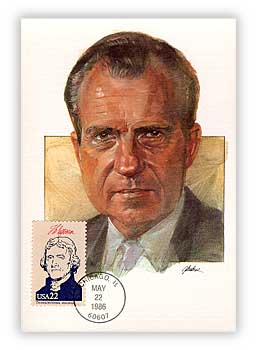
Initiatives under New Federalism were promoted with promises of greater state autonomy, as well as increased funding. Nixon saw the states and localities as better fiscal managers than the federal bureaucracy. But Nixon’s New Federalism did not push everything to the states. He understood that some issues cross state lines and others are just inherently national in scope. He divided and assigned responsibilities where he believed they belonged. Many of the new programs included unprecedented welfare and healthcare reform, environmental protection, and civil and equal rights acts, some of which are still in operation.
To achieve peace at home, Nixon knew he needed to tackle foreign affairs as well. He eventually established a working relationship with isolationist China, achieved détente with the Soviet Union, and pulled the United States out of Vietnam. Despite his distrust of Cuban President Fidel Castro, in 1970 Nixon even confirmed a preexisting peace accord between the nations. And although things escalated in the Middle East between Israel and her neighbors in 1973, almost causing nuclear war, Nixon’s involvement in peace negotiations brought the U.S. closer to both Egypt and Israel in the aftermath of the situation.
Nixon was also able to negotiate nuclear arms control agreements with the Soviet Union, a step that would contribute to the end of the Cold War years later. Trade was increased between the countries. And with nuclear peace within their grasp, they publicly declared a “new era of peaceful existence.â€
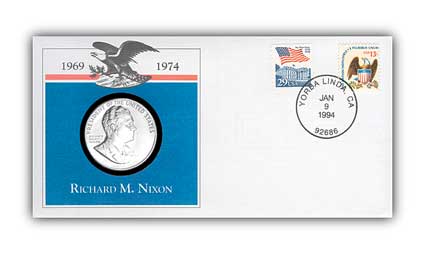
Biographers have described Nixon as almost paranoid in some respects. He generally thought the odds were against him and that he felt constantly “under siege.†He had a lengthy “List of Enemies†naming all of his perceived political nemeses. The Watergate scandal all started with “plumbers†being tasked with finding dirt on one of the enemies on Nixon’s list, Daniel Ellsberg. In 1971, Ellsberg had released the “Pentagon Papers,†revealing top-secret government decisions regarding the war in Vietnam. Nixon knew that most of the information would be lost on the public and that it tarnished the Kennedy and Johnson Administrations’ reputations more than his own. But even so, its publication could undermine the people’s trust in their government and Commander in Chief. An operation commenced to dig up dirt on Ellsberg to discredit him. But nothing was found. All charges against Ellsberg were eventually dropped. The Nixon White House was completely disgraced. With an election year fast approaching, Nixon could afford no further embarrassment.
At some point after the Pentagon Papers debacle, administrators in the Nixon White House decided to seek disparaging evidence against Democratic Presidential Candidate Senator George McGovern. Nixon believed McGovern was receiving campaign funds from communist supporters. In the spring of 1972, plans to break into McGovern’s campaign headquarters were hatched, but fell through. The new target became the Democratic National Committee (DNC) offices at the Watergate Hotel in Washington, D.C. That May, after two unsuccessful attempts, a team was able to break into the DNC offices and set up surveillance equipment. When the bugs and wiretaps began to fail, the team returned to the DNC on June 12, but were unable to accomplish their task. That day, the five men were caught and arrested for breaking in to the Democratic Committee offices at the Watergate Hotel.
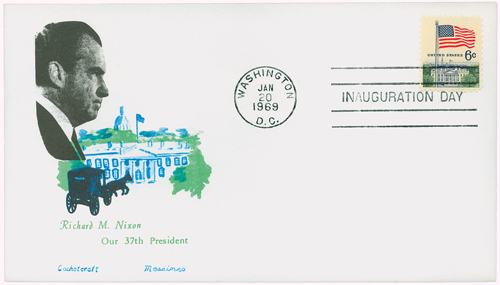
In November, Nixon won the 1972 election by a landslide. But by January, the Watergate investigation was well underway and fingers were starting to point toward the Oval Office. Within the year, Nixon himself had been implicated in the scandal and talks of impeachment were heard through Congress. The final blow came when transcripts of Nixon’s taped phone conversations were released. It became clear that while he may not have been behind the illegal activity at the Watergate Hotel, Nixon was up to his neck in the cover-up. With grounds for impeachment mounting, Nixon announced his resignation as President of the United States on August 8, 1974. He left office the next day.
After leaving office, Nixon retired with his wife to California. Only a month after resigning, President Ford pardoned him for any wrongdoing. Though personally protected from legal action, he was still subpoenaed in other trials related to Watergate. Despite this, Nixon still intended to return to public service in politics.
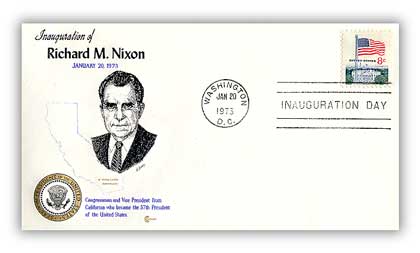
Over the next few years, Nixon penned his memoirs, participated in interviews, and made new political connections. He wrote ten books and numerous other published articles. He started to visit foreign countries and their leaders again, even attending the Shah of Iran’s funeral against the orders of the U.S. State Department. Once called “the senior statesman above the fray,†he had become a sort of independent politician. By the time of his death on April 22, 1994, Nixon had rehabilitated his image the best he could. But the association with corruption and scandal would forever accompany his name.
Â
Birth Of Richard NixonÂ

Richard Milhous Nixon was born into a poor Quaker family in Yorba Linda, California, on January 9, 1913.
Nixon excelled as a student and became a successful debater and public speaker during his high school years. While practicing law in California, Nixon participated in a local play, where he met his future wife, Thelma “Pat†Ryan.
Nixon’s political aspirations moved his family to Washington, D.C., in 1942, just as the United States was becoming heavily involved in World War II. A Quaker by birth, Nixon could have been exempt from military service, but he chose to enlist in the Naval Reserves. Early in the war, he served in the South Pacific as a naval passenger control officer. By its end, he had achieved the rank of lieutenant commander.
After the war, Nixon ran for and won a seat in California’s 12th Congressional District. He spent three years in the House, before winning a seat in the Senate. As a Senator, Nixon gave speeches across the country warning of the threat global communism posed. General Dwight Eisenhower soon selected this highly visible young politician as his running mate for the 1952 presidential election. It was during this campaign that Nixon had his first brush with scandal.
Though not illegal per se, vice-presidential candidate Nixon was accused of receiving reimbursement for political expenses from his supporters. If true, this might imply an unethical profit or a conflict of interest. Nixon took the bull by the horns and addressed the country on television – a fairly new media outlet at the time. In an eloquent live speech, Nixon explained to 60 million viewers that no wrongdoing had occurred, except perhaps one campaign gift that he refused to return – a cocker spaniel his six-year-old daughter had already bonded with. The speech was a huge success. Eisenhower and Nixon won the election less than two months later.
As vice president, Nixon had more responsibility than any man previously in the position. He was heavily involved in both domestic and foreign policy. He even acted in Eisenhower’s absence after the President suffered a heart attack and later a stroke, despite there being no constitutional authority for him to do so. But he never overstepped his bounds or tried to assume more power than was required at the time. Nixon’s efforts won him favor with the American public and he could see a successful bid for the presidency in his future.

The 1960 presidential race did not work out in Nixon’s favor. The popular, young, and charismatic John F. Kennedy won the election, but by a small margin. Nixon and his family quietly returned to California, later moving to New York, where he went back to practicing law. But Nixon stayed keenly aware of, and involved in politics.
In 1968, Nixon got back into the game and won the presidency. He took office eager to bring a divided country together, saying in his inaugural address, “the greatest honor history can bestow is that of peacemaker.â€
In an effort to slow inflation, Nixon uncharacteristically applied temporary wage and price freezes while searching for a better solution. He implemented “New Federalism†style programs that diverted certain rights and responsibilities back to the individual states. The plan was not to absolve the Federal Government of all accountability, but to lessen its administrative cost and burden, in theory.

Initiatives under New Federalism were promoted with promises of greater state autonomy, as well as increased funding. Nixon saw the states and localities as better fiscal managers than the federal bureaucracy. But Nixon’s New Federalism did not push everything to the states. He understood that some issues cross state lines and others are just inherently national in scope. He divided and assigned responsibilities where he believed they belonged. Many of the new programs included unprecedented welfare and healthcare reform, environmental protection, and civil and equal rights acts, some of which are still in operation.
To achieve peace at home, Nixon knew he needed to tackle foreign affairs as well. He eventually established a working relationship with isolationist China, achieved détente with the Soviet Union, and pulled the United States out of Vietnam. Despite his distrust of Cuban President Fidel Castro, in 1970 Nixon even confirmed a preexisting peace accord between the nations. And although things escalated in the Middle East between Israel and her neighbors in 1973, almost causing nuclear war, Nixon’s involvement in peace negotiations brought the U.S. closer to both Egypt and Israel in the aftermath of the situation.
Nixon was also able to negotiate nuclear arms control agreements with the Soviet Union, a step that would contribute to the end of the Cold War years later. Trade was increased between the countries. And with nuclear peace within their grasp, they publicly declared a “new era of peaceful existence.â€

Biographers have described Nixon as almost paranoid in some respects. He generally thought the odds were against him and that he felt constantly “under siege.†He had a lengthy “List of Enemies†naming all of his perceived political nemeses. The Watergate scandal all started with “plumbers†being tasked with finding dirt on one of the enemies on Nixon’s list, Daniel Ellsberg. In 1971, Ellsberg had released the “Pentagon Papers,†revealing top-secret government decisions regarding the war in Vietnam. Nixon knew that most of the information would be lost on the public and that it tarnished the Kennedy and Johnson Administrations’ reputations more than his own. But even so, its publication could undermine the people’s trust in their government and Commander in Chief. An operation commenced to dig up dirt on Ellsberg to discredit him. But nothing was found. All charges against Ellsberg were eventually dropped. The Nixon White House was completely disgraced. With an election year fast approaching, Nixon could afford no further embarrassment.
At some point after the Pentagon Papers debacle, administrators in the Nixon White House decided to seek disparaging evidence against Democratic Presidential Candidate Senator George McGovern. Nixon believed McGovern was receiving campaign funds from communist supporters. In the spring of 1972, plans to break into McGovern’s campaign headquarters were hatched, but fell through. The new target became the Democratic National Committee (DNC) offices at the Watergate Hotel in Washington, D.C. That May, after two unsuccessful attempts, a team was able to break into the DNC offices and set up surveillance equipment. When the bugs and wiretaps began to fail, the team returned to the DNC on June 12, but were unable to accomplish their task. That day, the five men were caught and arrested for breaking in to the Democratic Committee offices at the Watergate Hotel.

In November, Nixon won the 1972 election by a landslide. But by January, the Watergate investigation was well underway and fingers were starting to point toward the Oval Office. Within the year, Nixon himself had been implicated in the scandal and talks of impeachment were heard through Congress. The final blow came when transcripts of Nixon’s taped phone conversations were released. It became clear that while he may not have been behind the illegal activity at the Watergate Hotel, Nixon was up to his neck in the cover-up. With grounds for impeachment mounting, Nixon announced his resignation as President of the United States on August 8, 1974. He left office the next day.
After leaving office, Nixon retired with his wife to California. Only a month after resigning, President Ford pardoned him for any wrongdoing. Though personally protected from legal action, he was still subpoenaed in other trials related to Watergate. Despite this, Nixon still intended to return to public service in politics.

Over the next few years, Nixon penned his memoirs, participated in interviews, and made new political connections. He wrote ten books and numerous other published articles. He started to visit foreign countries and their leaders again, even attending the Shah of Iran’s funeral against the orders of the U.S. State Department. Once called “the senior statesman above the fray,†he had become a sort of independent politician. By the time of his death on April 22, 1994, Nixon had rehabilitated his image the best he could. But the association with corruption and scandal would forever accompany his name.





